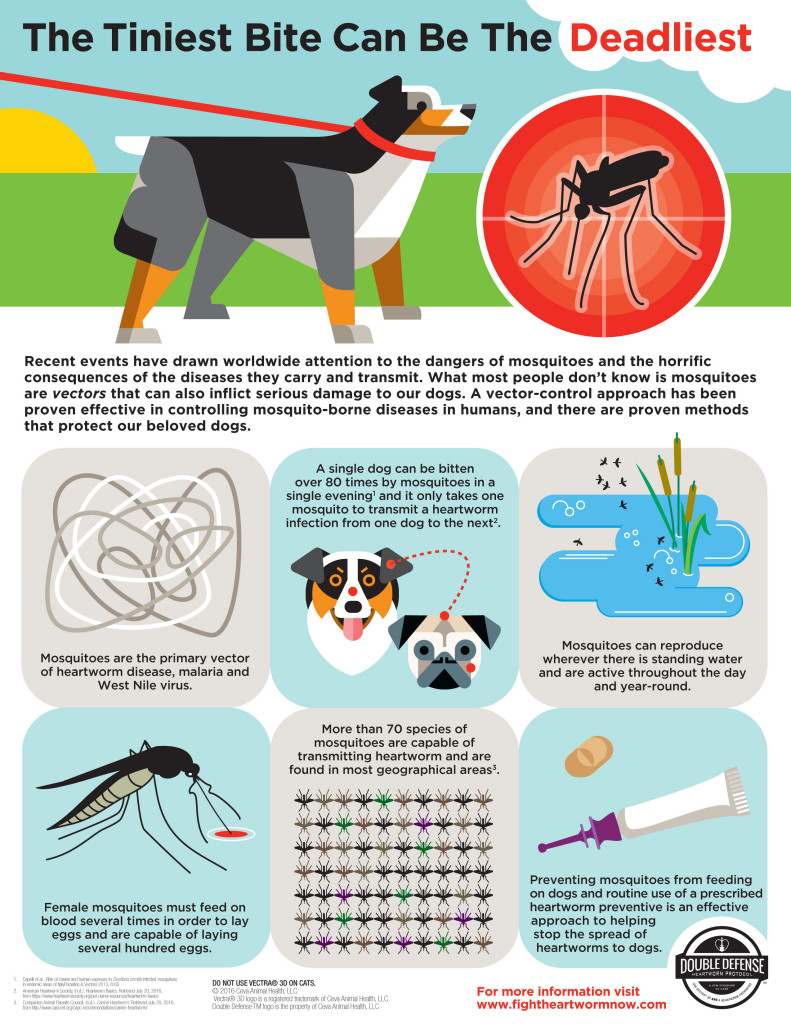This is an original post from Dr. Marty Becker, published on October 4, 2016.
Do you have questions about dogs and heartworm, including whether heartworm really is becoming resistant to preventives?
Some interesting results came out of a study of Ceva’s Vectra 3D flea/tick/mosquito repellant: It turns out it’s a powerful tool in the fight against canine heartworm disease, relying on what the company calls the “double defense” of a topical mosquito repellant combined with oral heartworm preventive.
I spoke with the researcher, Dr. John McCall, MS, PhD, professor emeritus in the Department of Infectious Diseases at the University of Georgia College of Veterinary Medicine, to learn more.
Note: This is not a sponsored post. I simply received a press release about the new study, and was inspired to investigate further and share what I learned with my readers.
Q: A lot of pet owners comment all the time that heartworm preventive “isn’t working” anymore. Do you feel that’s true, or if not true, a concern for the future?
A: The only way the average pet owner knows the preventive “isn’t working” is that their veterinarian tells them their dog has clinical signs of heartworm disease or is positive on an antigen test. If the dog was not infected prior to starting a prevention program and the owner has truly administered the preventive as instructed, a diagnosis of heartworm disease indicates the preventive has failed.
“Lack of efficacy” of a product is reported most often from the Mississippi Delta area, and the emergence of resistance in this part of the country has been documented. At this time, resistance has not been reported outside this area, but the spreading of resistance to other parts of the country is just a matter of time.
To date, however, the majority of cases in which the heartworm preventive appears not to be working are cases where the drug was not given at every time period where the possibility of mosquito bites existed. Thus, pet owners must be completely compliant with their preventive administration throughout the entire year.
And to defeat resistant strains of heartworm that might break through even the most compliant preventive administration, our best practice is to repel and kill the vector – the mosquito!
Q: How does an approach targeting the mosquito help with the challenge of resistance?
A: The “Double Defense” approach helps curb the spread of resistance because it equally blocks transmission of both resistant and susceptible heartworms.
Even if the preventive were only moderately effective in preventing infection in the animal, the concomitant use of a highly effective repellent/insecticide ensures that very few, if any, mosquitoes or animals get infected.
Vectra 3D also greatly reduces the spread of resistant heartworms by blocking the transmission of resistant microfilariae from infected dogs to mosquitoes.
In one of our recent studies, even the few mosquitoes that were able to feed on the infected dogs treated with Vectra 3D died long before they could develop the microfilariae to infective larvae (L3) and transmit the L3 to another animal.
Q: How does the combination of a repellant plus oral preventive compare in terms of efficacy to just preventive? How many cases of heartworm might be prevented through this double approach, if that’s known or can be estimated?
In our recent study in which resistant heartworms were used, all of the dogs that received only the preventive were infected and the overall heartworm burden in these dogs was reduced by only 59 percent, while the combination of preventive plus Vectra 3D was 98.5 percent effective as a repellent (anti-feeding effect) and 100 percent effective in preventing infection.
While it is virtually impossible to know or estimate how many cases of heartworms can be prevented by the use of the Double Defense approach, it is quite obvious from our laboratory study that the number of infected dogs and the number of worms per infected dog would be greatly reduced by this approach.
Q: What advantage does vector control over preventive have for the health of an individual dog, other than possible increased protection from heartworm – in other words, is there any other reason to prevent mosquitoes from biting a pet than just heartworm prevention?
West Nile Virus is known to be endemic in people in the USA. Zika virus has been diagnosed, and Dengue virus is considered a serious potential threat. All of these are transmitted by mosquitoes and although not proven, the use of repellent/insecticides on dogs might reduce the populations of mosquito vectors, particularly Aedes aegypti and A. albopictus, which carry these viruses.
Conventional heartworm preventives kill all the larvae that have accumulated in the dog’s body since the last treatment. Some of these larvae may be at least one month old when the dog is treated. It is not known exactly how long these larvae live in the dog after the preventive is given. Vectra 3D blocks transmission (~98 percent) by repelling the mosquito before it bites the dog and transmits the heartworm infective larvae.
In addition to assisting in the prevention of transmission of diseases caused by viruses and worms, the repellent insecticide-treated dog will experience fewer mosquito bites, with the irritation and blood loss that those bites cause. This alone is a big help to any pet!
Q: Are there any risks to cats in close contact with a family dog on this product?
The active ingredients in Vectra 3D are extremely safe for humans and dogs. When applied to a dog and allowed to dry, they represent no threat even to cats.
Cats become intoxicated if they ingest (consume) an excessive dose of permethrin, but they do not have adverse reactions to living with a treated dog, even if they like to groom the dog, as long as the product is allowed to dry on the dog.
Drying time after application takes anywhere from an hour or two to several hours, depending on ventilation around the dog. It is best if the dog is allowed to be in a well-ventilated place or even outdoors immediately after application of the product, away from cats, where spreading and drying can occur rapidly.
Q: Anything I didn’t ask you about that you think would be of interest to dog owners?
Owners can see fleas and ticks and know when they have a problem, but they cannot see heartworms, so they often forget the importance of the disease and the need to treat the animal to prevent it.
When they use a “Double Defense” approach, they get the added benefit of mosquito repellency/insecticidal efficacy. Thus, the use of Vectra 3D along with a conventional heartworm preventive ensures the highest level of heartworm protection, even against resistant heartworms.
Even though we do have treatments for existing heartworm infection in a dog, we now understand that the damage the worms do when they live in the heart and lungs of the pet can be irreversible after the infection is cured. Thus, it can be said that while the infection is curable, the damage done to the pet is not curable. If pet owners understood this, they would never allow their beloved pet to be unprotected for even a brief time.
Another aspect for pet owners to consider is the additive damage of a once-infected pet becoming infected again. So, proper care of the once heartworm-positive pet must include scrupulous preventive double defense.
For more information, visit http://www.fightheartwormnow.com/
Source: drmartybecker.com



